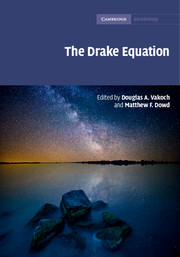Book contents
- The Drake EquationEstimating the Prevalence of Extraterrestrial Life through the Ages
- Cambridge Astrobiology
- The Drake Equation
- Copyright page
- Dedication
- Contents
- Contributors
- Foreword
- Preface
- Book part
- Introduction
- 1 Rate of formation of stars suitable for the development of intelligent life, R*, pre-1961
- 2 Rate of formation of stars suitable for the development of intelligent life, R*, 1961 to the present
- 3 Fraction of stars with planetary systems, fp, pre-1961
- 4 Fraction of stars with planetary systems, fp, 1961 to the present
- 5 Number of planets, per solar system, with an environment suitable for life, ne, pre-1961
- 6 Number of planets, per solar system, with an environment suitable for life, ne, 1961 to the present
- 7 Fraction of suitable planets on which life actually appears, fl, pre-1961
- 8 Fraction of suitable planets on which life actually appears, fl, 1961 to the present
- 9 Fraction of life-bearing planets on which intelligent life emerges, fi, pre-1961
- 10 Fraction of life-bearing planets on which intelligent life emerges, fi, 1961 to the present
- 11 Fraction of civilizations that develop a technology that releases detectable signs of their existence into space, fc, pre-1961
- 12 Fraction of civilizations that develop a technology that releases detectable signs of their existence into space, fc, 1961 to the present
- 13 Length of time such civilizations release detectable signals into space, L, pre-1961
- 14 Length of time such civilizations release detectable signals into space, L, 1961 to the present
- Afterword
- Index
- References
8 - Fraction of suitable planets on which life actually appears, fl, 1961 to the present
Published online by Cambridge University Press: 05 July 2015
- The Drake EquationEstimating the Prevalence of Extraterrestrial Life through the Ages
- Cambridge Astrobiology
- The Drake Equation
- Copyright page
- Dedication
- Contents
- Contributors
- Foreword
- Preface
- Book part
- Introduction
- 1 Rate of formation of stars suitable for the development of intelligent life, R*, pre-1961
- 2 Rate of formation of stars suitable for the development of intelligent life, R*, 1961 to the present
- 3 Fraction of stars with planetary systems, fp, pre-1961
- 4 Fraction of stars with planetary systems, fp, 1961 to the present
- 5 Number of planets, per solar system, with an environment suitable for life, ne, pre-1961
- 6 Number of planets, per solar system, with an environment suitable for life, ne, 1961 to the present
- 7 Fraction of suitable planets on which life actually appears, fl, pre-1961
- 8 Fraction of suitable planets on which life actually appears, fl, 1961 to the present
- 9 Fraction of life-bearing planets on which intelligent life emerges, fi, pre-1961
- 10 Fraction of life-bearing planets on which intelligent life emerges, fi, 1961 to the present
- 11 Fraction of civilizations that develop a technology that releases detectable signs of their existence into space, fc, pre-1961
- 12 Fraction of civilizations that develop a technology that releases detectable signs of their existence into space, fc, 1961 to the present
- 13 Length of time such civilizations release detectable signals into space, L, pre-1961
- 14 Length of time such civilizations release detectable signals into space, L, 1961 to the present
- Afterword
- Index
- References
Summary
An assessment of fl depends heavily upon perspectives gained from the single known example of our own biosphere. Extrapolating this single data point to a quantitative estimate of fl amounts to sheer speculation. But recent discoveries have identified perspectives about our biosphere and early planetary environments that are quite relevant to fl and that also benefit our search for a second example of life elsewhere. This chapter addresses these topics from the following perspectives: concepts of life, life's environmental requirements, early conditions on rocky planets, and the origins of life. The habitability of a planetary environment is defined by the intrinsic environmental requirements of life, which, in turn, arise from the most universal attributes of life itself. Key environmental requirements include a suitable solvent, the chemical building blocks of life, biologically useful sources of energy, and environmental conditions that favor the survival of key complex molecules and structures. The earliest evidence of our biosphere now extends back to more than 3.7 billion years ago, essentially as old as the oldest rocks that could have preserved recognizable evidence. The most ancestral characteristics of microbial metabolism are broadly consistent with the resources that were likely available as early as 4.4 billion years ago. Organic compounds relevant to prebiotic chemistry have been discovered in primitive bodies (e.g., meteorites, comets) and in interstellar space, and these might have been delivered intact to planetary surfaces. Thus, life might have begun very soon after habitable conditions were established. Regarding the origins of life, biochemical research is narrowing the knowledge gap between prebiotic chemicals and the first living systems. RNA molecules could have served as both self-replicators and enzymes. The earliest functional protein enzymes might have been much smaller in size and thus perhaps easier to develop than previously imagined. The prebiotic environment could have provided molecules that formed vesicles as precursors of cellular envelopes. Although the evidence certainly cannot prove the notion that another young Earth-like planet probably also sustained an origin of life, the evidence is at least quite consistent with the notion that life can arise early on Earth-like planets. Also, the evolution of stars and planets follows trajectories that allow reasonable estimations to be made of long-term changes in planetary climates and habitability. Thus, although recent discoveries have not yet reduced the enormous uncertainty in estimating fl, they have substantially improved our strategies for seeking a second example of life that would, in turn, substantially reduce that uncertainty.
- Type
- Chapter
- Information
- The Drake EquationEstimating the Prevalence of Extraterrestrial Life through the Ages, pp. 145 - 162Publisher: Cambridge University PressPrint publication year: 2015

